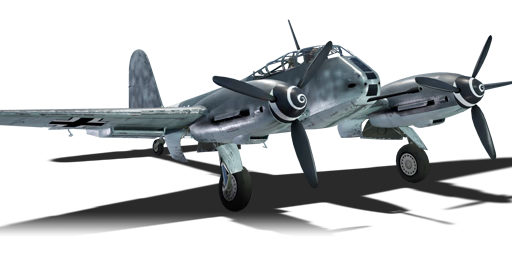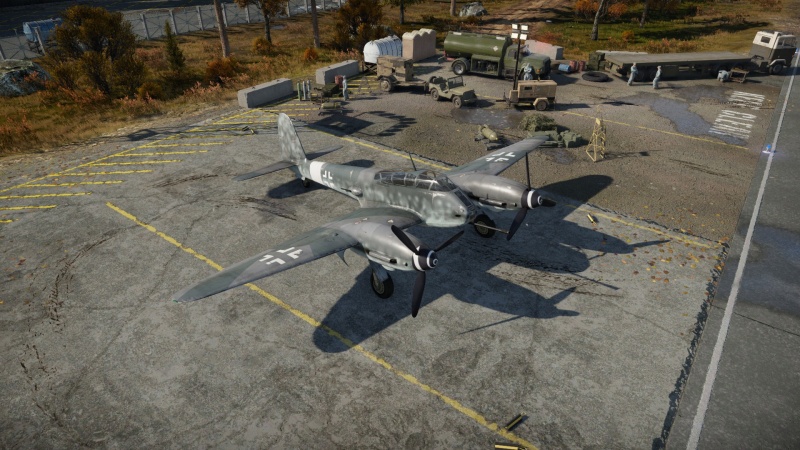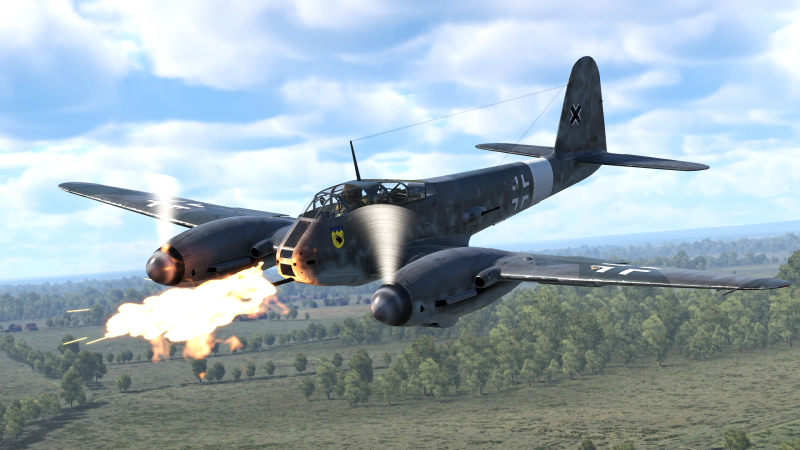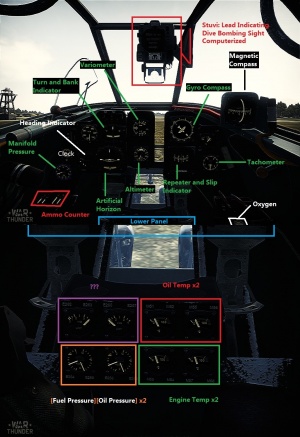Difference between revisions of "Me 410 A-1/U4"
m (Specs-Card ArtImage Added.) |
(Updated description to new format) |
||
| (One intermediate revision by one other user not shown) | |||
| Line 11: | Line 11: | ||
== Description == | == Description == | ||
<!-- ''In the description, the first part should be about the history of and the creation and combat usage of the aircraft, as well as its key features. In the second part, tell the reader about the aircraft in the game. Insert a screenshot of the vehicle, so that if the novice player does not remember the vehicle by name, he will immediately understand what kind of vehicle the article is talking about.'' --> | <!-- ''In the description, the first part should be about the history of and the creation and combat usage of the aircraft, as well as its key features. In the second part, tell the reader about the aircraft in the game. Insert a screenshot of the vehicle, so that if the novice player does not remember the vehicle by name, he will immediately understand what kind of vehicle the article is talking about.'' --> | ||
| − | The | + | The Me 410 first originated in the Me 210, which was a double-engined heavy fighter and ground attacker. The 410 was developed as a massive improvement over the Me 210 and solved many of its issues. When the Me 410 entered service, it was first utilized as a high-speed bomber. However, Luftwaffe Bomber Command grew displeased with the 410's performance as a bomber and opted to change its role. At this time, Germany was also in great need of a heavy fighter that could attack Allied bomber formations. This led to the Me 410's purpose changing to attack enemy aircraft. Aircraft that were originally intended to bomb were reconverted to the Zerstörer standard. In 1943, orders came down to equip heavy fighters with large calibre cannons to attack enemy aircraft as well as ground-attack. Out of the three cannons proposed, the KwK 5 cm was repurposed for aircraft use. Around 60 Me 410 A-1/U4s were built, but German command also came to the conclusion that the BK 5 cannon was too much. Later variants would drop the 50 mm cannon and simply added more cannons. |
| − | |||
| − | |||
| + | The '''{{Specs|name}}''' has been in the game since the start of the Open Beta Test prior to Update 1.27. The main point of focus on this vehicle is the 50 mm [[BK 5 (50 mm)|BK 5]] cannon in the nose. For its size, it holds a very respectable 22 rounds of ammunition. The specialty ammunition belts consist of one "Armored target" belt loaded with APCBC-HE-T rounds, a second "Armored target" belt loaded with HVAP-T (APCR) rounds, and one "Air target" belt with Minengeschoße HEI-T rounds. However, the default belt contains a one-to-one mix of the AP-T and HEI-T rounds, making it difficult to specialize in a specific role in the battle. It's best suited to equip the BK 5 cannon with the armoured target belt (AP-T) and use the [[MG 151 (20 mm)|MG 151]]s against aircraft. | ||
== General info == | == General info == | ||
=== Flight performance === | === Flight performance === | ||
Latest revision as of 23:48, 13 October 2023
| This page is about the German strike aircraft Me 410 A-1/U4. For other versions, see Me 410 (Family). |
Contents
Description
The Me 410 first originated in the Me 210, which was a double-engined heavy fighter and ground attacker. The 410 was developed as a massive improvement over the Me 210 and solved many of its issues. When the Me 410 entered service, it was first utilized as a high-speed bomber. However, Luftwaffe Bomber Command grew displeased with the 410's performance as a bomber and opted to change its role. At this time, Germany was also in great need of a heavy fighter that could attack Allied bomber formations. This led to the Me 410's purpose changing to attack enemy aircraft. Aircraft that were originally intended to bomb were reconverted to the Zerstörer standard. In 1943, orders came down to equip heavy fighters with large calibre cannons to attack enemy aircraft as well as ground-attack. Out of the three cannons proposed, the KwK 5 cm was repurposed for aircraft use. Around 60 Me 410 A-1/U4s were built, but German command also came to the conclusion that the BK 5 cannon was too much. Later variants would drop the 50 mm cannon and simply added more cannons.
The Me 410 A-1/U4 has been in the game since the start of the Open Beta Test prior to Update 1.27. The main point of focus on this vehicle is the 50 mm BK 5 cannon in the nose. For its size, it holds a very respectable 22 rounds of ammunition. The specialty ammunition belts consist of one "Armored target" belt loaded with APCBC-HE-T rounds, a second "Armored target" belt loaded with HVAP-T (APCR) rounds, and one "Air target" belt with Minengeschoße HEI-T rounds. However, the default belt contains a one-to-one mix of the AP-T and HEI-T rounds, making it difficult to specialize in a specific role in the battle. It's best suited to equip the BK 5 cannon with the armoured target belt (AP-T) and use the MG 151s against aircraft.
General info
Flight performance
Describe how the aircraft behaves in the air. Speed, manoeuvrability, acceleration and allowable loads - these are the most important characteristics of the vehicle.
| Characteristics | Max Speed (km/h at 6,600 m) |
Max altitude (metres) |
Turn time (seconds) |
Rate of climb (metres/second) |
Take-off run (metres) | |||
|---|---|---|---|---|---|---|---|---|
| AB | RB | AB | RB | AB | RB | |||
| Stock | 566 | 552 | 9400 | 32.2 | 33.1 | 7.9 | 7.8 | 530 |
| Upgraded | 613 | 590 | 29.9 | 31.0 | 14.3 | 10.8 | ||
Details
| Features | ||||
|---|---|---|---|---|
| Combat flaps | Take-off flaps | Landing flaps | Air brakes | Arrestor gear |
| ✓ | ✓ | ✓ | ✓ | X |
| Limits | ||||||
|---|---|---|---|---|---|---|
| Wings (km/h) | Gear (km/h) | Flaps (km/h) | Max Static G | |||
| Combat | Take-off | Landing | + | - | ||
| 750 | 350 | 457 | 428 | 280 | ~12 | ~4 |
| Optimal velocities (km/h) | |||
|---|---|---|---|
| Ailerons | Rudder | Elevators | Radiator |
| < 360 | < 360 | < 460 | > 265 |
| Compressor (RB/SB) | ||
|---|---|---|
| Setting 1 | ||
| Optimal altitude | 100% Engine power | WEP Engine power |
| 5,300 m | 3,020 hp | 3,330 hp |
Survivability and armour
- 8 mm Steel - Nose armour
- 60 mm Bulletproof Glass
- 12 mm Steel - Headrest
- 8 mm Steel - Cockpit mid plate
- 8 mm Steel - Rear gunner plate
- 9 mm Steel - Rear boom armour plate
- 9 mm Steel - Liquid cooling protective armour
- 5 mm Steel - Wing leading edge armour
- 8 mm Steel - Engine nacelle fore and aft plates
Modifications and economy
Armaments
Offensive armament
The Me 410 A-1/U4 is armed with:
- 1 x 50 mm BK 5 cannon, chin-mounted (22 rpg)
- 2 x 20 mm MG 151 cannons, cheek-mounted (350 rpg = 700 total)
Defensive armament
The Me 410 A-1/U4 is defended by:
- 1 x 13 mm MG 131 machine gun, 2 x beam turrets (500 rpg)
Usage in battles
The Me 410 A-1/U4 is an air vehicle that performs well in two different roles. The first is bomber interception due to its large calibre 5 cm BK 5 cannon, but the poor climb rate when compared to other variants of the 410 limit its effectiveness in this mission. Granted, single-handedly shooting down heavy bombers is quite enjoyable from a pure gameplay perspective. The excellent armour-piercing capabilities of Me 410 A-1/U4 cannon make ground attack a viable option. However, the Hs 129B-3 with its 7.5 cm BK 7,5 cannon can deliver more punch to its target while an aircraft armed with 3.7 cm weapons can also penetrate the rear and side armour of all types of armoured vehicles while having more ammunition at their disposal. For this reason, bomber interception might be a more viable option. Of course, enemy fighters will be your primary concern, since the Me 410 A-1/U4 has poor climb rate and turn time, but your rear machine guns with good firing radius can provide some retribution.
The heavy BK 5 cannon degrades flight performance considerably, making it hard get on your opponent's rear and use your powerful MG 151/20. The best tactic to counter enemy fighters is to retain energy and use Boom & Zoom attacks. If a friendly fighter is near, make sure to ask him for help.
Manual Engine Control
| MEC elements | ||||||
|---|---|---|---|---|---|---|
| Mixer | Pitch | Radiator | Supercharger | Turbocharger | ||
| Oil | Water | Type | ||||
| Not controllable | Controllable Auto control available |
Not controllable Not auto controlled |
Controllable Not auto controlled |
Combined | Not controllable 1 gear |
Not controllable |
Pros and cons
Pros:
- Great manoeuvrability for a two-engine heavy fighter
- Good dive performance
- Good survivability
- Potent offensive firepower
- The 50 mm cannon can knock out bombers in one shot
- High ammo count
Cons:
- High-calibre cannon air targets belt lacks versatility
- 50 mm cannon is inaccurate and almost useless against fighters
- 50 mm cannon is long to reload, delaying the follow-up shot
- 50 mm shell rarely kills ground units in one shot
History
| Archive of the in-game description | |
|---|---|
|
The Me 410 A-1/U4 and the Me 410 A-2/U4 became the most powerful armament available in Me 410 A modifications. They provided a 50 mm Rheinmetall BK 5 cannon. This weapon was initially developed as an antitank gun, with a 21-round drum magazine and a pneumatic reloading system, and was mounted in the bomb bay. The presence of the BK 5 cannon had no discernible effect on piloting the aircraft; however, the Me.410's flight characteristics were slightly reduced due to increased aerodynamic resistance. Tests showed that an aircraft with the 50 mm BK 5 cannon was able to target T-34 and KV tanks as well as railway carriages, steam locomotives, and small waterborne vehicles. However, it turned out that the standard Revi 16 sight was not suitable for firing the new weapon, so planes armed with BK 5 cannons were fitted with ZFR 4a gun sights. Firing practice showed that the BK 5 cannon frequently failed when firing long bursts (more than five shells). This problem was solved when a special automatic breaker limiting bursts to three rounds was introduced into the fire control circuit. The Me 410 A never became an anti-tank aircraft; instead, the Hornets armed with the 50 mm BK 5 cannons targeted American heavy bombers. Firing tests targeting B-17 and B-24 bombers that had been forced to land in German territory showed that a hit with only one 50 mm shell was usually enough to destroy a bomber. The principal beam, one of the most durable structural members of the aircraft, was easily destroyed with a hit from one of the shells. The bombers' fuel tanks, which were safely protected with sponge rubber from any through shots from small-calibre weapons, would detonate when hit by BK 5 cannon shells, turning large pieces of the skin and the airframe of the wing inside out. In theory, German pilots could shoot down enemy planes while remaining out of the reach of their defensive fire. But in real combat conditions it was not easy for Me 410 crews to win duels with the escort fighters, not only with the newest P-51 Mustangs but also with the P-47 Thunderbolts and the P-38 Lightnings. 50 mm BK 5 cannons were installed on Me 410 A-1/U4s on the front, replacing the 20 mm Mauser MG 151/20 cannons and 7.92 mm Rheinmetall-Borsig MG 17 machine guns. The Me 410 A-2/U4 "destroyers" ("Zerstörer") were equipped with BK 5 cannons directly at the factory and retained all of their standard armament. | |
Media
- Skins
See also
Links to the articles on the War Thunder Wiki that you think will be useful for the reader, for example:
- reference to the series of the aircraft;
- links to approximate analogues of other nations and research trees.
External links
| Germany strike aircraft | |
|---|---|
| Messerschmitt | |
| Bf 110 | Bf 110 C-6 · Bf 110 C-7 · Bf 110 F-2 · Bf 110 G-2 · Bf 110 G-4 |
| Me 410 | Me 410 A-1 · Me 410 A-1/U4 · Me 410 B-1 · Me 410 B-2/U4 · Me 410 B-6/R3 |
| Dornier | |
| Do 335 | Do 335 A-0 · Do 335 A-1 · Do 335 B-2 |
| Focke-Wulf | |
| Fw 190 | Fw 190 F-8 |
| Heinkel | |
| He 219 | He 219 A-7 |
| Henschel | |
| Hs 129 | Hs 129 B-2 · Hs 129 B-2 (Romania) · Hs 129 B-3 |
| Junkers | |
| Ju 87 | Ju 87 G-1 · Ju 87 G-2 |
| Foreign: | |
| USSR | ▀IL-2 (1942) |







